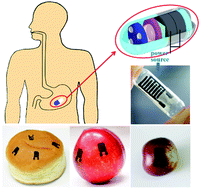A directly swallowable and ingestible micro-supercapacitor†
Abstract
The fast-growing demand for a painless diagnosis with high security and accuracy during detection drives the miniaturization of medical appliances. Owing to the uncertainties of the pathological properties for most reported biocompatible materials and to the discontinuity of electrode components under complex and variable surface strains, the newly emerging degradable energy devices often possess unpredictable performance and huge safety risks in the diagnostic process, particularly during in vivo experiments. Drawing inspiration from the electrochemical behavior of natural food, here we present an edible micro-supercapacitor (EMSC) made on food constituents via a template-imprinting strategy, in which all of the electrodes and electrolyte are ingestible, swallowable, and non-toxic to humans. We also show that the high mechanical stability and flexibility of the EMSC endow it with strong environmental adaptability that can be imprinted onto arbitrarily shaped objects, including polymer planar surfaces and non-planar surfaces (such as skin, fruit and bread). Moreover, the EMSC displays an outstanding performance with a high energy density of 10.86 μW h cm−2 and power density of 0.78 mW cm−2, which could light a red LED by two EMSCs connected in series. Moreover, this micro-device can be coiled into a shell of a medical capsule to provide power to capsule endoscopy in a simulated gastric juice environment. The prominent properties of the micro-supercapacitor pave the way towards real-time in vivo detection and other biological application possibilities.



 Please wait while we load your content...
Please wait while we load your content...